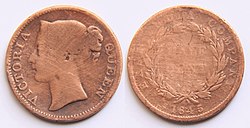Loading AI tools
Monetary unit in many national currencies From Wikipedia, the free encyclopedia
The cent is a monetary unit of many national currencies that equals a hundredth (1⁄100) of the basic monetary unit. The word derives from the Latin centum, 'hundred'.
This article needs additional citations for verification. (September 2022) |

The cent sign is commonly a simple minuscule (lower case) letter c. In North America, the c is crossed by a diagonal or vertical stroke (depending on typeface), yielding the character ¢.
The United States one cent coin is generally known by the nickname "penny", alluding to the British coin and unit of that name. Australia ended production of their 1¢ coin in 1992, as did Canada in 2012. Some Eurozone countries ended production of the 1 euro cent coin, most recently Slovakia in 2022.[1]
The cent may be represented by the cent sign, written in various ways according to the national convention and font choice. Most commonly seen forms are a minuscule letter c crossed by a diagonal stroke, a vertical line, a simple c, depending on the currency (see below). Cent amounts from 1 to 99 can be represented as one or two digits followed by the appropriate abbreviation (2¢, 5c, 75¢, 99c), or as a subdivision of the base unit ($0.75, €0.99). In some countries, longer abbreviations like "ct." are used. Languages that use other alphabets have their own abbreviations and conventions.
The cent symbol has largely fallen into disuse since the mid-20th century as inflation has resulted in very few things being priced in cents in any currency. It was included on US typewriter keyboards, but has not been adopted on computers.[2]
The cent sign appeared as the shift of the 6 keys on American manual typewriters, but the freestanding circumflex on computer keyboards has taken over that position. The character (offset 162) can still be created in most common code pages, including Unicode and Windows-1252:
A2 that can be used when there is no numeric keypad, as on many laptops. For the US International keyboard Right Alt⇧ ShiftC can be typed.When written in English and Mexican Spanish, the cent sign (¢ or c) follows the amount (with no space between)—for example, 2¢ and $0.02, or 2c and €0.02. Conventions in other languages may vary.
| East India Company half cent (1845). | |
|---|---|
 | |
| Obverse: Crowned head left with lettering Queen Victoria | Reverse: Face value, year and "East India Company" inscribed inside wreath. |
| 18,737,498 coins minted in 1845. | |
Examples of currencies around the world featuring centesimal (1⁄100) units called cent, or related words from the same root such as céntimo, centésimo, centavo or sen, are:
Examples of currencies featuring centesimal (1⁄100) units not called cent
Examples of currencies which formerly featured centesimal (1⁄100) units but now have no fractional denomination in circulation:
| Major unit | Formerly divided into |
|---|---|
| Costa Rican colón | (until the 1980s) 100 céntimos |
| Czech koruna | 100 haléřů |
| Hungarian forint | (until 1999) 100 fillér |
| Icelandic króna | 100 eyrir (singular aurar) |
| Japanese yen | 100 sen |
| Norwegian krone | 100 øre |
| South Korean won | 100 jeon |
| Swedish krona | (until 2010) 100 öre |
| Ugandan shilling | (until 2013) 100 cents. |
Examples of currencies which use the cent symbol for other purposes:
Seamless Wikipedia browsing. On steroids.
Every time you click a link to Wikipedia, Wiktionary or Wikiquote in your browser's search results, it will show the modern Wikiwand interface.
Wikiwand extension is a five stars, simple, with minimum permission required to keep your browsing private, safe and transparent.